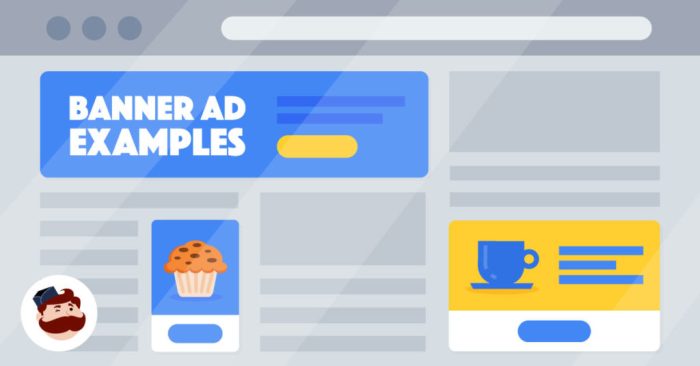
High-converting banner ad examples open the door to understanding the art and science behind effective online advertising. These ads not only grab attention but also compel viewers to take action, making them a crucial element of digital marketing strategies. Well-designed banner ads from renowned brands demonstrate the powerful impact of visuals, messaging, and strategic placement in capturing audience interest.
This exploration delves into successful campaigns, highlighting design techniques and targeted strategies that lead to impressive conversion rates. As we navigate through these examples, you’ll discover the key components that make banner ads an essential tool in the online marketing landscape.
Examples of High-Converting Banner Ads
High-converting banner ads are essential for successful online marketing campaigns. These ads not only capture attention but also drive traffic and conversions. Notable companies have mastered the art of creating effective banner ads that resonate with their target audience and yield impressive results. Below, we’ll explore some well-known examples and analyze successful campaigns that highlight key design elements and strategies.
Well-Known Companies Using Effective Banner Ads
Numerous companies have effectively utilized banner ads to boost their visibility and sales. Here are some notable examples:
- Amazon: Known for its seasonal promotions and targeted advertising, Amazon uses personalized banner ads that reflect user preferences, significantly increasing click-through rates.
- Netflix: With captivating imagery and strong calls to action, Netflix effectively showcases its latest shows and movies, enticing users to subscribe or revisit the platform.
- Dropbox: The company’s banner ads focus on the simplicity and utility of its service, often highlighting customer testimonials that build trust and encourage sign-ups.
- Airbnb: By using high-quality images of unique accommodations and local experiences, Airbnb’s banner ads create an emotional connection, driving users to explore travel options.
- Spotify: Spotify maximizes engagement with vibrant visuals and interactive elements that promote their latest playlists and features, fostering user interaction.
Case Studies of Successful Banner Ad Campaigns
Examining successful banner ad campaigns provides insights into what elements contribute to high conversion rates. Here are a couple of case studies that illustrate effective strategies:
-
Case Study: Crazy Egg
Crazy Egg utilized A/B testing to refine its banner ads, focusing on different headlines and images. Their successful campaign resulted in a 30% increase in conversions by optimizing the call to action and using contrasting colors to grab attention. The formula was simple:“Test, analyze, and iterate.”
-
Case Study: HubSpot
HubSpot’s banner ads emphasized educational content with clear messaging. By using infographics and concise text, they improved user understanding of their services, leading to a 40% increase in lead generation. Their campaign demonstrated the importance of informative content that resonates with target audiences.
Design Techniques for High Conversion Rates
Effective banner ad design incorporates several key techniques that enhance visibility and engagement. The following design elements are critical for maximizing conversion rates:
- Strong Visuals: High-quality images and graphics draw attention and create an emotional response, making the ad more memorable.
- Color Contrast: Utilizing contrasting colors for calls to action ensures they stand out, directing users’ eyes to key areas of the ad.
- Clear Typography: Legible fonts and concise messaging help convey the ad’s purpose quickly, ensuring that users can easily grasp the message at a glance.
- Call to Action: Effective CTAs are essential for prompting user action. Phrases like “Sign Up Now” or “Get Started Today” create urgency and encourage clicks.
- Responsive Design: Banner ads should be optimized for various devices, ensuring a seamless user experience across desktops, tablets, and smartphones.
Strategies for Effective Banner Advertising

Effective banner advertising goes beyond just eye-catching visuals; it involves a strategic approach that combines design, messaging, and targeting to create ads that resonate with users. The primary goal is to engage potential customers and drive them toward taking action, whether that’s clicking through to a website or making a purchase. Understanding the essential elements of successful banner ads and applying best practices can significantly enhance their effectiveness.
Key Components of Engaging Banner Ads
To create banner ads that capture attention and drive conversions, several components must be considered. These elements include:
- Compelling Visuals: High-quality images or graphics that are relevant to the message and appealing to the target audience.
- Clear Messaging: A succinct and powerful message that communicates the value proposition quickly, often within the constraints of limited space.
- Effective Call-to-Action (CTA): A strong and clear CTA that encourages users to take the desired action, such as “Shop Now” or “Learn More.”
- Brand Consistency: Ensuring that the banner aligns with the overall branding strategy, including color schemes, fonts, and logos.
- User-Centric Design: Adapting the design to enhance usability and focus on the target audience’s preferences and behaviors.
Best Practices for Targeting Demographics
Targeting specific demographics is crucial for maximizing the impact of banner ads. By understanding the audience’s characteristics, advertisers can tailor their messages effectively. Here are some best practices:
- Utilize Data Analytics: Analyze user data to identify key demographics such as age, gender, interests, and online behavior.
- Segment Audiences: Create different banners for various segments to address their unique needs and preferences.
- Leverage Retargeting: Use retargeting strategies to engage users who have previously interacted with your brand, increasing the chances of conversion.
- Choose the Right Platforms: Select platforms that are popular with your target audience to ensure that the ads reach the intended viewers.
- Test Different Approaches: Experiment with various messages and designs to see which resonates best with different demographic groups.
Importance of A/B Testing in Optimization
A/B testing, or split testing, is a fundamental practice for optimizing banner ad performance. This method involves comparing two versions of an ad to determine which one performs better.
- Improves Click-Through Rates: By testing different elements (like headlines, colors, and CTAs), advertisers can identify which variations drive more user engagement.
- Data-Driven Decisions: A/B testing provides concrete data on user preferences, allowing marketers to make informed choices rather than relying on assumptions.
- Enhances ROI: Continuous optimization through A/B testing can significantly improve return on investment by ensuring that ad spend is directed toward the most effective campaigns.
- Identifies Audience Trends: Testing various designs and messages can reveal changing trends in audience preferences, helping to keep the ads relevant.
“Without testing, you’re just guessing.”
The Role of Banner Ads in Online Marketing
Banner ads serve as a vital component of an effective digital marketing strategy, helping brands achieve visibility and drive conversions. They are designed to capture attention quickly, making them a powerful tool for delivering targeted messages to potential customers. As online advertising continues to evolve, understanding the role of banner ads becomes essential for marketers aiming to enhance their overall promotional efforts.In the context of a comprehensive digital marketing strategy, banner ads fit seamlessly into various channels, complementing email marketing, social media, and content marketing campaigns.
By creating visually appealing and relevant ads, businesses can reach their target audience effectively while reinforcing their brand message across multiple platforms.
Relationship Between Banner Advertising and Email Marketing Success
The synergy between banner advertising and email marketing can significantly enhance marketing outcomes. Banner ads can effectively complement email campaigns by extending a brand’s reach and improving engagement. For instance, banner ads can be strategically placed on websites that align with the target audience of specific email campaigns, thus maximizing visibility and driving traffic to landing pages.Moreover, incorporating banner ads in email newsletters can reinforce call-to-action buttons, ensuring that recipients have multiple avenues to engage with the brand.
This holistic approach not only boosts open and click-through rates but also cultivates a more cohesive brand experience.
Effectiveness of Banner Advertising Across Different Platforms
The effectiveness of banner ads can vary considerably depending on the platform used for advertising. Understanding these differences is crucial for optimizing campaigns and allocating budgets effectively. Here’s a comparison of banner advertising performance across several key platforms:
- Social Media: Platforms like Facebook, Instagram, and LinkedIn offer targeted advertising options that enable brands to reach specific demographics based on user behavior and interests. The visual nature of these platforms makes them ideal for creative banner ads that engage users as they scroll through their feeds.
- Websites and Blogs: Displaying banner ads on relevant websites allows brands to connect with audiences already interested in their niche. The context of the surrounding content can enhance ad relevancy, leading to higher click-through rates.
- Mobile Apps: With mobile usage on the rise, advertising through mobile apps has become increasingly effective. Banner ads in apps often reach users during moments of downtime, making them more likely to engage.
- Search Engines: While not traditional banner ads, display ads on search engines like Google can capture a wide audience. These ads work well to re-engage users who have previously interacted with the brand.
“The right banner ad at the right time can be the catalyst for increased conversions and customer engagement.”
In summary, incorporating banner ads into a multi-channel digital marketing strategy not only increases brand visibility but also enhances overall campaign effectiveness. By leveraging the unique advantages of each platform and understanding their relationship with other marketing efforts, businesses can optimize their advertising approaches for maximum impact.
Summary

In summary, the journey through high-converting banner ad examples reveals the intricate balance of creativity and strategy required for effective online advertising. By analyzing successful campaigns and understanding the critical elements that drive conversions, marketers can enhance their own advertising efforts. Embracing these insights will help you craft compelling banner ads that not only attract clicks but also generate tangible results in your marketing endeavors.
FAQ Insights
What makes a banner ad effective?
An effective banner ad captures attention through eye-catching design, clear messaging, and a strong call-to-action.
How important is A/B testing for banner ads?
A/B testing is crucial for optimizing banner ads, as it allows marketers to compare different designs and messages to determine which performs better.
Can banner ads be effective on social media?
Yes, banner ads can be highly effective on social media platforms, especially when tailored to fit the platform’s audience and format.
What demographics should I target with my banner ads?
Your target demographics should align with your product or service offerings, based on factors like age, interests, and online behavior.
How can I measure the success of my banner ads?
Success can be measured through metrics such as click-through rates, conversion rates, and return on ad spend.





